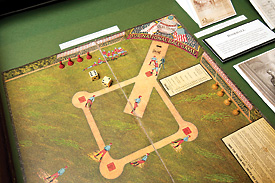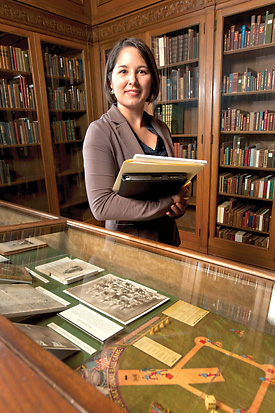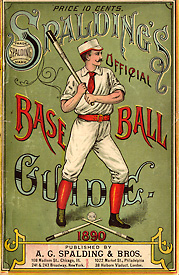Today the Internet, cell phones, digital music and other tech boom innovations have sparked a communications revolution.
But a century before, society was rocked on a similar scale.

“Our National Ball Game,” a board game produced by McGill & Delany of Philadelphia in 1887, is displayed in the William L. Clements Library exhibit “The Games We Played: Sports in Nineteenth Century America.”.
By the 1890s, a surging population of urban workers — no longer required to work from sunup to sundown on the farm — were discovering leisure time. And they found a number of ways to fill it.
“The Games We Played: Sports in Nineteenth Century America,” a new William L. Clements Library exhibit, offers rare books, manuscripts, prints, photographs and more to illustrate the new pastimes of 19th century Americans. It is presented 1-5 p.m. Monday through Thursday in the library’s Great Hall through Oct. 7.
“It was an explosion,” says Emiko Hastings, exhibit curator. “In the 19th century, as life became increasingly urban and industrialized, activities like hunting, fishing and running went from essential subsistence skills to entertainments reserved for leisure time. Some of the most popular sports today, including baseball, basketball and football, were first developed in the 19th century.”

Emiko Hastings is curator of “The Games We Played: Sports in Nineteenth Century America,” a new William L. Clements Library exhibit, which presents manuscripts, prints, photographs and rare books to illustrate the growing leisure activities of Americans in the 1800s. Photo by Scott Soderberg, U-M Photo Services.
The exhibit features items pulled from all five divisions of the library — books, manuscripts, maps, graphics and culinary history. It presents the first published rulebooks for sports including baseball, golf and bowling; how-to books on bicycling, camping, croquet and other leisure activities; and statistical records for track and field, baseball and other emerging sports.
Among unique items in the exhibit is a bound collection of the magazines “Bang: Boxing’s Weekly Wallop,” from 1936-38. “The previous owner had the binding made of cloth from Joe Louis’s training shirt, with part of his mouth guard inlaid into the front cover,” Hastings says. The headband of the book is from the lining of a punching bag used by boxer Lou Ambers, a tailband made from trunks used by Johnny Greo, and a cover title leather strip from gloves used by Louis Kaplan.
James Naismith, who invented basketball in 1891, recalled his creation in a 1939 letter. It is contained in the James Naismith Collection donated to the library by Duane Norman Diedrich, and displayed in the exhibit. “I have frequently been asked to put on a game resembling the first one,” Naismith wrote. “I have asked that they find 18 young men 23 to 30 years of age, with mustaches and who had never seen read or heard of a game of basketball, and then I could put on a good representation of the first game.”
Also displayed is the book “American Football,” by Walter Camp, from 1891.“It was one of the first to codify football as a sport and to set all the rules,” Hastings says. Camp, who served as head coach at Yale from 1888-92, was regarded as the “Father of American Football” for his role in shaping the sport. The volume was small enough to fit in a pocket; making it a good size to bring to a game for consulting over rules disputes.

Many sports celebrated in the 19th century remain as popular or more popular today, but interest faded in some. While the exhibit celebrates women’s participation in sporting activities including softball, golf and tennis, photos also offer evidence of the female broom brigades of the late 19th century. “Wearing uniforms and carrying brooms instead of guns, they performed military drills and marches and participated in patriotic events like Fourth of July parades,” Hastings says.
The book “The Sporting Man’s Companion: Containing Prize Ring, Pedestrianism, Running Records, Baseball Scores and Averages, and Other Interesting Sporting Statistics in All Branches of Sports,” edited by William Harding, New York, 1886, prominently mentions in its title pedestrianism. This signifies that this form of speed walking had a following. “It was a popular spectator sport in the 19th century, along with running and horse racing. Participants competed for large cash prizes while the crowds wagered on the outcomes.” Hastings says.
The exhibit also displays late 1800s gymnastics manuals. While gymnastics can be traced to ancient times, its modern form is attributed to a movement in Germany in the early 19th century to balance education with physical activity, Hastings says. Gymnastics spread to other European countries and to the United States by the 1880s. In addition to apparatus such as the balance beam, pommel horse, vault and parallel bars, gymnastic exercises also included juggling, tumbling, rope climbing and calisthenics.
John J. Miller, a University of Michigan alumnus and author of “The Big Scrum: How Teddy Roosevelt Saved Football,” will deliver a lecture to accompany the exhibit at the library on September 14.
Other items presented in the exhibit include:
• Our National Ball Game, a board game from 1887 featuring a lively graphic depiction of a baseball diamond. The game was played with tokens and dice.
• A photo of an African-American baseball team, posed sitting on a fence outside a Maryland fruit orchard. “It’s one of the few images the library has of African-American sports players from that time,” Hastings says.
• The book “John L. Sullivan, Life and Reminiscences of a Nineteenth Century Gladiator,” London: G. Routledge and Sons, 1892. It is one of the first books celebrating a sports celebrity.
• An Aug. 17, 1897 letter from Theodore Roosevelt to U.S. Navy official Russell Alger seeking the revival of football games between Annapolis and West Point. Roosevelt, who was named assistant secretary of the Navy that year, was known to love football. He asked Alger to consider reinstating the rivalry between the two teams, suspended earlier due to violence.
• Spalding’s Official Golf Guide Containing Constitution, By-Laws and Rules of the United States Golf Association, Instructions for Beginners, Records, Illustrations of the Different Methods of Driving, 1898. The USGA, formed four years earlier in 1894, continues to govern the game today.
The exhibit also celebrates through handbooks, drawings, photos and even sheet music the popularity of cycling, curling, yachting, lacrosse, tennis, badminton, camping horse racing and other sports and activities.
“The Games We Played: Sports in Nineteenth Century America”
1-5 p.m. Monday through Thursday through Oct. 7 in the William L. Clements Library’s Great Hall

